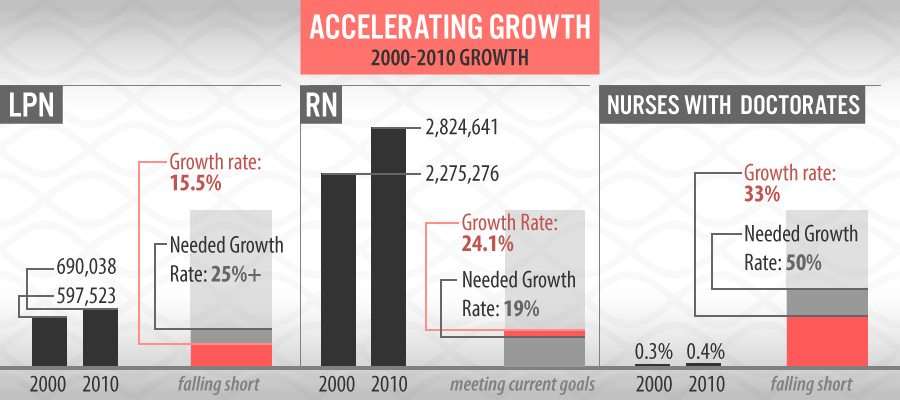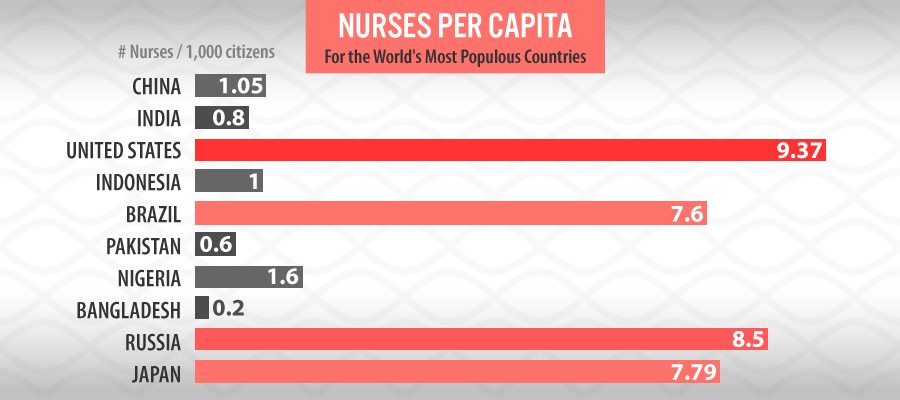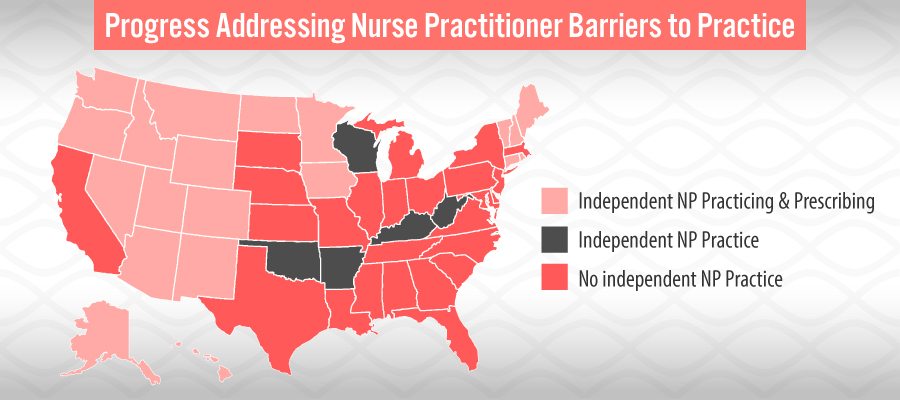The Demand For Nurses
The demand for nurses is not limited to one city or state and the entire country is experiencing a nursing shortage. You’ve probably been hearing about the nursing shortage for a while now. It’s true — due to aging nurses edging towards retirement, and the relatively unchanging number of nursing graduates — we’re set to need tons of new nurses and fast. The real picture is slightly more complex, however. As highly skilled nurses are placed in leadership positions and technological advances streamline nursing care, the barrier between patients and highly-skilled nursing care has never been lower.
Though even with pipelines of foreign nurses migrating to the first world, it’s not enough. While America is set to hit max aging with their population, the developing world is becoming home to a majority of a new generation aged 14 and younger (and accounting for over 1/4th of the world’s population). If you think we need more nurses now, wait until 2020.
Needed: More Nurses with Better Education
Featured Programs
From the year 2000 to 2030, the number of Americans aged 65 and older will have doubled to over 72 million people. Meanwhile, from 2013-to 2014 alone, the number of uninsured Americans dropped by 3.8 million. If you think that seems like a lot of patients for the some 2.7 million registered nurses in America to handle, you’re right. According to the BLS, nurses are one of the most in-demand professions for the 2012-2022 time frame.

The RN workforce is expected to grow from 2.71 to 3.24 million by 2022. This increase of 19% will involve over 500,000 new positions. Coupled with the close to 500,000 retiring nurses — particularly from high-stress and turnover positions — over one million replacement nurses will be needed by the early 2020’s. The numbers for LPN’s are even more drastic, with an estimated 25% increase in job openings from 2012-2022. Note that those are the expected job openings, and without restructuring or technological advancements will likely not be enough of a workforce increase to fully account for increased medical demands. Needless to say, demand for nurses has never been higher.
A landmark study on the future of nursing by the Robert Wood Johnson Foundation notes that not only will the number of nurses in the nation need to increase, but their skills will need to increase as well. Though the recession eased the nursing shortage somewhat — due to the number of people returning to school to retool as nurses — the AACN reported that there was only a 2.6% increase in baccalaureate-level nursing program enrollments in 2013. Currently, only 55% of registered nurses hold a baccalaureate or graduate-level degree. A number that needs to increase to 80% to meet current demands according to the Future of Nursing. With nurses taking on new and varied roles and leadership positions, there is currently a need for twice as many nurses holding doctorate degrees.
Getting Older and Younger
Two massive demographic shifts will increasingly affect nursing needs throughout the coming decades: a rapidly aging America, and a developing world that comprises a majority of the world’s youth. In the US, aging populations will affect both the supply and demand of nursing workforces. The need for geriatric and home care nurses will compound the overall need for nurses, as nurses serving in geriatric and home care settings do not also work in a hospital and primary care settings.
While life expectancy is growing in the developing world as well, developing nations are currently experiencing the fastest population growth of any nation, and comprise the majority of the population of people under the age of 14. Currently, the population of those under the age of 14 makes up over a quarter of the world’s population (26.3%), and are uniquely benefited by access to nurses in a variety of roles: from lowering infant mortality, to providing vaccines, to getting a hold of preventable diseases at an early age.
Note that as members of the aging general population, the average age of nurses is also increasing, precipitating a compounded need for new nurses as the first large generation to work through to retirement age begins to retire. From 2000-2010 the number of nurses aged 51-70 doubled for each respective 5-year age group. In fact, nurses aged 46-60 compose three of the five largest five-year age groups for working nurses.
With the older among them hitting retirement age, the first wave of additional nursing openings has begun and will reach a head when the largest group of nurses–51-55 years of age in 2010–start to reach retirement age in 2020. While worth the cost, this also becomes a monetary issue at scale, with the American Hospital Association estimating that it costs between $30,000 and $64,000 per nurse to replace.
Nurses Per Capita

The demographic shift aside, the developing world is often stuck with dangerously low nursing per capita levels as more developed countries are able to lure nurses to migrate for greater professional opportunities and pay. Latin America and the Caribbean currently have about 1.25 nurses per 1,000 residents.
The ratio in the US and most developed countries is about 10 times the number. For the world’s second-most populous country–India–even Latin American numbers look good, with .8 nurses per 1,000 citizens. A number close to their doctor ratio of 1 for every 1,700 citizens. Of the world’s ten most populous countries, only four nations have nurse-per-capita rates at first-world levels. The population of the other 6 most populous nations totals 3.2 billion people or almost half of the planet.
Technology and Barriers to Entry
While the U.S. (and the WORLD) are going to need a ton of nurses to keep up with health care demand over the coming years, a number of developments can help streamline the ability of current nurses to reach potential patients. Other developed nations have implemented medical models in which nurses can take over as primary caretakers of patients, as opposed to doctors. And technological advancements–including the expansion of “telemedicine”– can help minimize barriers between patients and nursing care.
Barriers of entry to leadership positions for nurses on regulatory or hospital-based fronts for nurses often center around problematic perceptions of nursing by hospital administrators and regulators. Of the top 4 major barriers to nurses attaining leadership roles in medicine–according to nurses–doctors being seen as the primary source of revenue in medical settings, and the visibility of nurses in policymaking are one and two, respectively.
Coming in as a large concern for 68% and 67% of nurses surveyed is the lack of a single voice for nurses in regards to state issues and the public perception of nurses–as compared to physicians–as important health care decision-makers. Nowhere is this more clear than in the widely varied roles of nurse practitioners. Noting the map above, nearly as many states allow nurse practitioners to both practices independently and prescribe medicines as don’t even allow nurse practitioners to have their own practices.
While policy, education, and demographic changes will dramatically morph the nursing profession over the coming years, technological advancements and how nurses adapt to them will probably dictate large portions of nursing demand over the coming years. “The Impact of Emerging Technology on Nursing Care” a recent article in the Online Journal of Nursing Care Issues outlines 7 key areas in which nursing-related technology is rapidly advancing: genetics and genomics, less invasive and more accurate diagnostic testing, 3-D printing, robotics, biometrics, electronic healthcare records, and entry and decision support.
Most Implemented Technologies
Perhaps the two most implemented of these technologies include less invasive and more accurate diagnostic testing and electronic healthcare records. In the coming years, a growing reliance on both robotics and the role of underlying genetic or environmental influences in treating diseases will require new nurses to expand skill sets and continually learn to keep up with advancements.
While everyone agrees that we aren’t on track to address the increased demand for nurses over the next decade, the real picture is a bit more complicated. Increased education in the current nursing force, coupled with lowered barriers to placing nurses in leadership positions and technological advancements could drastically increase the ability of our current nursing workforce to address needs.
On a global scale, even slightly raising nurse per capita ratios in many regions could drastically improve the quality of life of countless people–with nurses and midwives seen as some of the most cost-effective medical practitioners to put on the ground in the developing world. If you’re currently in school for nursing, now is an exciting time. Up-to-date training with developing technologies and management methods is increasingly valuable. And nurses are needed in almost every specialty. If you’re looking for a profession with which to make a difference over the coming decades, few can compete with the field of nursing.
Related:
